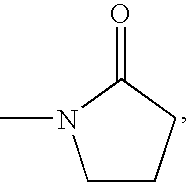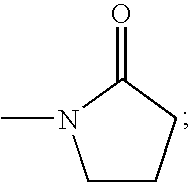Microporous polymer separators for lithium ion batteries and method for producing the same
a lithium ion battery and microporous polymer separator technology, applied in the field of manufacturing batteries and capacitors, can solve the problems of poor lithium battery, poor compatibility of polyolefin with electrolyte solution (polar organic solvent), and membrane piercing phenomenon, and achieves the effect of preventing short-circuit and dendrite penetration of batteries, high porosity, and large surface area
- Summary
- Abstract
- Description
- Claims
- Application Information
AI Technical Summary
Benefits of technology
Problems solved by technology
Method used
Image
Examples
example 1
Preparation of Microporous Polymer Membrane
Step 1: Synthesis of Polymer Colloidal Emulsion
[0035]In this example, water-soluble polymer emulsion used for lithium-ion battery membrane was prepared through polymerization reaction generated by hydrophilic polymer polyvinyl alcohol (PVA) 1750 and lipophilic monomer vinyl acetate (VAC) / ethylacrylate (EA) / acrylonitrile (AN) in water solution. The composing of copolymer was PVA:VAC:EA:AN=10:2:2:5 (weight ratio, the same hereinafter). The content of copolymer is 17%. The product was white opaque emulsion.
[0036]The polymer emulsion was prepared through following steps: 1000 g distilled water and 100 g polyvinyl alcohol (PVA) 1750 were added to four-neck reaction vessel fixed condenser. The temperature of the reaction vessel was heated to 75° C. under stirring at 100 rpm. After 3 h, the material was transparent like can be regarded as dissolved finished. After natural cooling to 55° C., 40 g mixture of lipophilic monomer vinyl acetate (VAC) an...
example 2
Preparation of Microporous Polymer Membrane
Step 1: Synthesis of Polymer Colloidal Emulsion
[0040]The reaction steps are basically the same as EXAMPLE 1 The only difference is that the lipophilic monomer ethyl acrylate (EA) was replaced by acrylamide (AM). The composing of copolymer was PVA:VAC:AM:AN=10:2:1:8.
[0041]The concrete preparation method of the polymer emulsion is as follows:
[0042]All monomers were added in one time. The concentrations of materials were adjusted to about 13%. Initiator was added directly. The slurry experienced colorless-light blue-white emulsion process. The reaction rate was faster than EXAMPLE 1. After 12 h reaction, polymer emulsion used for lithium batteries was obtained.
Step 2: Preparation of Slurry
[0043]The amount of filler is the same as EXAMPLE 1. The materials are titanium dioxide and benzyl alcohol. The mixture was grinded with a ball grinder for 5 h. The viscosity of the slurry was kept at 2500 mpa·s by adjusting the solid content at the temperatu...
example 3
Step 1: Synthesis of Polymer Colloidal Emulsion
[0044]In this example, polyvinyl alcohol 1788 (PVA) was added to lipophilic monomer styrene (St) / butyl acrylate (Ba) / acrylonitrile (AN). Water-soluble polymer emulsion used for lithium-ion battery membrane was prepared by ternary polymerization in aqueous phase. The composing of copolymer was PVA:St:Ba:AN=10:2:4:5 (weight ratio, the same hereinafter). The content of copolymer is 17%. The product was white opaque emulsion.
[0045]The polymer emulsion was prepared through following steps: 1000 g distilled water and 100 g polyvinyl alcohol (PVA) 1788 were added to four-neck reaction vessel fixed condenser. The temperature of the reaction vessel was heated to 90° C. under stirring at 100 rpm. After 3 h, the material was transparent like can be regarded as dissolved finished. After natural cooling to 65° C., styrene monomer and a little initiator were added. About 20 minutes later, the mixture became a white emulsion. In the meantime, butyl ac...
PUM
| Property | Measurement | Unit |
|---|---|---|
| temperature | aaaaa | aaaaa |
| temperature | aaaaa | aaaaa |
| temperature | aaaaa | aaaaa |
Abstract
Description
Claims
Application Information
 Login to View More
Login to View More - R&D
- Intellectual Property
- Life Sciences
- Materials
- Tech Scout
- Unparalleled Data Quality
- Higher Quality Content
- 60% Fewer Hallucinations
Browse by: Latest US Patents, China's latest patents, Technical Efficacy Thesaurus, Application Domain, Technology Topic, Popular Technical Reports.
© 2025 PatSnap. All rights reserved.Legal|Privacy policy|Modern Slavery Act Transparency Statement|Sitemap|About US| Contact US: help@patsnap.com


